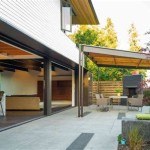How To Build A Pea Gravel Patio On Sloped Ground
Constructing a pea gravel patio on sloped ground presents a unique set of challenges compared to building on a level surface. Careful planning and execution are crucial to ensure the patio remains stable, functional, and aesthetically pleasing. This article provides comprehensive instructions on how to build a pea gravel patio on sloped ground, addressing the specific considerations required for successful construction.
Planning and Preparation: Understanding the Slope and Determining the Patio's Layout
The initial phase of building a pea gravel patio on a slope involves a thorough assessment of the existing terrain. Understanding the degree of the slope is paramount. This assessment will influence the design, drainage solutions, and the amount of material required. Simple tools like a level, a string, and a measuring tape can be used to determine the slope's gradient over a reasonable distance. Documenting the slope's characteristics through sketches or photographs is also recommended for later reference.
Determining the patio's layout requires careful consideration of the surrounding landscape and intended use. On a sloped surface, the patio's shape may need to be adjusted to better integrate with the natural contours. Consider terracing the patio into different levels if the slope is significant. Terracing reduces the overall angle of the slope, providing more usable and level areas within the patio. The layout should also consider factors such as sunlight exposure, prevailing winds, and proximity to existing structures. Mark the proposed patio boundaries using stakes and string, allowing for visual assessment and adjustments before any excavation work begins.
Drainage is a critical consideration when building on sloped ground. Water runoff can erode the pea gravel and destabilize the patio's base. Plan for adequate drainage solutions, such as installing a French drain system. A French drain consists of a perforated pipe surrounded by gravel, buried underground to collect and redirect water away from the patio. The drain should be positioned at the uphill side of the patio to intercept surface water runoff. The slope of the French drain should be carefully calculated to ensure efficient water flow towards a designated drainage area, which could be a dry well, a drainage ditch, or a connection to the existing stormwater system.
Once the layout and drainage plans are finalized, compile a list of necessary materials and tools. This list includes pea gravel, base material (crushed stone or gravel), landscape fabric, lumber or edging material for retaining walls (if terracing), French drain components (perforated pipe, gravel), shovels, rakes, a compactor, a level, a measuring tape, and safety gear (gloves, eye protection). Calculate the quantity of each material based on the patio's dimensions and the desired depth of each layer. It is always prudent to order slightly more material than calculated to account for compaction and potential waste.
Excavation and Base Preparation: Creating a Stable Foundation on Sloped Ground
The excavation process prepares the ground for the patio's base. Remove any vegetation, topsoil, and debris within the marked patio boundaries. The depth of excavation will depend on the desired thickness of the base and pea gravel layers, typically ranging from 6 to 12 inches. Ensure that the excavation extends beyond the proposed patio edges to accommodate any retaining walls or edging materials. If terracing, excavate each level separately, creating a series of stepped areas. Maintain a consistent slope for drainage within each level during excavation.
Construct any planned retaining walls or edging structures before proceeding with the base material. Retaining walls are essential for terraced patios, providing structural support and preventing soil erosion. Use durable materials such as treated lumber, natural stone, or concrete blocks for retaining wall construction. Ensure that the retaining walls are properly leveled and secured, with adequate backfilling and drainage provisions. Edging materials, such as landscape timbers or metal edging, can be used to define the patio's perimeter and contain the pea gravel.
Once the excavation and retaining wall construction are complete, install a layer of landscape fabric over the excavated area. Landscape fabric prevents weed growth and helps to stabilize the base material. Overlap the fabric seams by at least 12 inches to ensure complete coverage. Secure the fabric edges using landscape staples or rocks to prevent shifting during the base material installation. Trim any excess fabric after the base material is in place.
The base material provides a stable and well-draining foundation for the pea gravel. Use crushed stone or gravel as the base material, spreading it evenly over the landscape fabric. The thickness of the base layer should be at least 4 to 6 inches, depending on the soil conditions and anticipated traffic. Use a rake to distribute the base material uniformly and ensure a consistent slope for drainage. Compact the base material using a plate compactor or hand tamper. Compaction is crucial for creating a solid and level surface. Add additional base material as needed to fill any low spots and maintain the desired level. Repeat the compaction process until the base is firm and stable.
Pea Gravel Installation and Finishing Touches: Achieving a Smooth and Functional Surface
With the base properly prepared, it's time to install the pea gravel. Choose a pea gravel size and color that complements the surrounding landscape and aligns with your aesthetic preferences. Pea gravel is typically available in sizes ranging from 1/4 inch to 3/8 inch. Deliver the pea gravel to the patio area using a wheelbarrow or similar equipment. Spread the pea gravel evenly over the compacted base material, aiming for a layer thickness of 2 to 4 inches.
Use a rake to distribute the pea gravel uniformly, filling in any low spots and ensuring a smooth, level surface. The pea gravel should completely cover the base material, creating a consistent texture and appearance. If terracing, install the pea gravel on each level separately, working from the upper levels downwards. Pay attention to the edges of the patio, ensuring that the pea gravel is flush with the edging materials or retaining walls. Add additional pea gravel as needed to achieve the desired thickness and levelness.
After installing the pea gravel, compact the surface lightly using a roller or hand tamper. Light compaction helps to settle the pea gravel and create a more stable surface. Avoid over-compacting the pea gravel, as this can reduce its drainage capacity and make it uncomfortable to walk on. Rake the surface again after compaction to smooth out any unevenness. Water the pea gravel lightly to help it settle and further consolidate. This step can also help to remove any dust or debris from the surface.
Inspect the finished patio for any drainage issues or areas of instability. If water is pooling in certain areas, adjust the slope or add additional drainage solutions. Ensure that the pea gravel is properly contained within the edging or retaining walls to prevent erosion. Add any desired decorative elements, such as stepping stones, planters, or outdoor furniture. Arrange the furniture and accessories to create a comfortable and inviting outdoor space. Regularly maintain the pea gravel patio by raking it to remove debris and replenish any lost gravel. Periodically check the drainage system to ensure that it is functioning properly. With proper planning, construction, and maintenance, a pea gravel patio on sloped ground can provide a beautiful and functional outdoor living space for years to come.

Hillside Gravel And Timber Path Done Digging

Diy Pea Gravel Patio

How To Buil A Pea Gravel Patio

Can I Build A Path With Pea Gravel And Pavers On Slope

Our Diy Gravel Patio Project Was Simple But Labor Intensive Find More Details And Tips About The On Blog Heywanderer Com

Hillside Gravel And Timber Path Done Digging

Diy Pea Gravel Patio With Pavers Love Renovations

Hillside Gravel And Timber Path Done Digging

How To Make A Gravel Path With Stepping Stones Hometalk

Diy Pea Gravel Patio With Pavers Love Renovations
See Also








